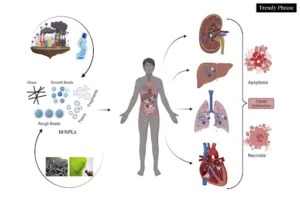The issue of microplastic pollution is gaining popularity. Scientists have discovered these small plastic particles for the first time in human blood. In a study of 22 healthy adults, researchers found microplastics in 80% of those tested. This discovery now raises the chilling prospect that pollutive plastic may develop into a serious health hazard by finding its way into vital organs.
How Do Microplastics Enter the Human Body?
Microplastics are everywhere, contaminating anything from the air to water and food. Microplastics have already been detected in human feces, and with blood tests indicating they can be transferred throughout the body, we have everything to fear. Sources of exposure include:
- Drinking from plastic bottles
- Consuming food in plastic packaging
- Breathing in airborne microplastics
- Using plastic-containing personal care products
What Did the Study Reveal?
The research, published in Environment International, detected different types of plastics in the blood samples:
- 50% contained PET plastic, widely used in beverage bottles.
- 33% had polystyrene, commonly found in food packaging.
- 25% contained polyethylene, used in plastic bags.
These figures show that plastic contamination is common and inevitable. Microplastic contents also vary with temporary exposure, e.g., using a coffee cup lined with plastic or using a plastic mask on the face.

Potential Health Risks of Microplastics in Blood
The long-term effects of microplastics in the bloodstream are unknown, but scientists are worried about their health-threatening capacity. Microplastics have been shown to damage human cells in laboratory experiments. Evidence exists linking air pollution particles with a lot of premature deaths annually.
Among some of these alarming facts are:
- Microscale particles can accumulate in organs and damage them.
- They can stick to red blood cells and partly reduce oxygen uptake in the body.
- Microplastics have even been found in placentas, raising concerns about fetal development.
- Have been found in the brains and hearts of fetuses from pregnant rats.
Desperate Need for More Research
Professor Dick Vethaak, one of the prominent researchers, articulates the need for further studies regarding how microplastics interact with the human body. Key questions include:
- Do microplastics get permanently lodged in organs?
- Can they cross the blood-brain barrier?
- Are they present in high enough concentrations to cause disease?
Governments and research institutions are now being urged to invest more in research. The EU has already started researching the impact of microplastics on unborn babies, infants, and the immune system, with environmental groups in the UK demanding a £15 million investment in researching their impacts on health.
The Rising Plastic Crisis
Production of plastic is predicted to double by 2040, making the problem of plastic pollution even worse. If microplastics are already in the human bloodstream, their long-term consequences will become a serious public health problem. There should be action now to stop plastic waste and implement policies that limit human exposure.

How to Reduce Personal Exposure to Microplastics
- Filtered Tap Water Change: Switching to filtered tap water instead of bottled water reduces microplastic consumption from about 90,000 particles to just 4,000 a year.
- No-heating With Plastics: Use alternative plates and vessels to store and heat food, like glass and stainless steel. Do not allow microplastics to leach into the food during microwaving.
- Limit Plastic Kitchenware Usage: Limiting microplastic contamination in food can be done through the use of wooden, glass, or metal utensils and storage.
- Processed Foods: They are more contaminated with microplastics, and thus, limiting their intake helps minimize health exposure to such whole fresh foods.
- Support Environmental Actions: Getting involved in or supporting policies that will decrease plastic pollution can help lead to overall efforts in reducing microplastic contamination.
These steps can assist in lowering the potential health hazard of microplastics, leading to overall well-being.
Final Thoughts
The microplastics that have been found in human blood could transform our perspectives and redefine the history of the effects of plastic pollution on the human race. Immediate research is required for long-term health impacts on the assumption that microplastics are now able to move through the body and directly influence major organs. This recent discovery has been an eye-opener and has added to the long list of human concerns. The sad part is that despite knowing that our Earth is changing, we are still not ready to change ourselves. But the critical question is till when?



